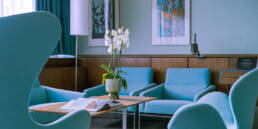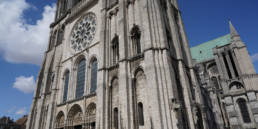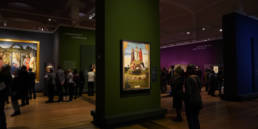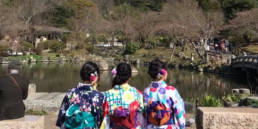Budapest is a city built quickly, during a few spectacular years of wealth, ca 1880 to 1900. Hungarian architects of this period, forced to put up spectacular buildings overnight, became masters of stucco and plaster work, which covered homey brick bases. Buildings were never plain during this period, but always featured some kind of interesting decoration.
Colourful ceramics were also used, especially under the direction of the Secessionist architect Odon Lechner(1845-1914), and while these have often retained their original splendour, most of the other architectural elements of the city have suffered years of neglect.

WWII did not destroy the city as badly as one would think. It is only after the second world war, when Hungary became a communist state, that the city’s architecture suffered. The violent peoples’ revolution of 1956 caused much damage, including bullet holes that can sometimes be spotted still dotting facades. In the 50’s and 60’s, many of the previous century’s large, beautiful buildings were divided up into horrible apartment units. As the need for practical housing grew, communist apartment blocks went up, devoid of any decoration or elements considered unnecessary. The 19th-century buildings fell into neglect and accumulated dirt. The plaster started to fall off, revealing brick skeletons, but there was no money nor desire, it seems, to fix them. After 1989 some restoration programs have taken place, but the city is still a fascinating mix of styles and contrasts.
Secessionist facades

My favourite period by far is the Austro-Hungarian answer to Art Nouveau, called Secession (also visible in Vienna). This style, whose major proponent was Odon Lechner, was (in Budapest) conceived of as being typically Hungarian, truly eastern, deriving from folk designs but incorporating eastern influences (possibly due to the long Turkish occupation of the country). But interesting also is the assortment of “historicist” styles, glances back to all periods of western art history, with imitations of gothic, baroque and classical art often mixed together anachronistically.
The seedy side: Ugly Budapest

It seems important to point out some examples of the more regular buildings or more normal looking streets — it is easy for a tourist to photograph 19th century buildings because this is what we are likely to find beautiful.
But it is also historically interesting to document 1970’s apartment buildings and other, even earlier communist elements. Most of the latter have been removed from the city, as if removing communist sculpture (to a purpose-designed park in the suburbs) was enough to remove years of oppression from peoples’ memories and years of accumulated dirt from the city’s buildings.

Matayas Church

Matayas church is one of my favourite places in Budapest. The 13th century origins of this Gothic church may be found in a stone or two, but, after a series of occupations and other functions, the original structure of the building is all but obscure.


In the late 19th century it was “restored” by the architect Frigyes Schulek, who finished it in 1896. Every surface in the interior of the church is entirely covered in colourful painted patterns by the artist Bertalan Szekely. The result is what I would call “Disneyland Gothic“: the patterns are supposedly of Gothic inspiration but also work in folk tradition, floral motifs and numerous disctinctly Art Nouveau elements.

The church now houses the crown of St. Stephen, the country’s oldest treasure and also the most valuable. It is excellently presented in a dedicated room in the triforium (upstairs level), where there are explanatory signs in numerous languages. There is a small entry fee to the building (600 ft) which is well worth it for the excellent lighting and full access it provides.
Sign up to receive future blog posts by email
Alexandra Korey
Alexandra Korey aka @arttrav on social media, is a Florence-based writer and digital consultant. Her blog, ArtTrav has been online since 2004.
Related Posts
September 18, 2019
Re-Discovering Chartres: the Gothic Cathedral and Beyond
March 31, 2019
Mantegna and Bellini – Berlin exhibition review
May 1, 2018




